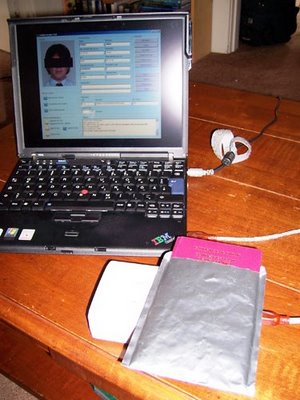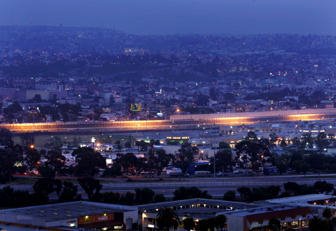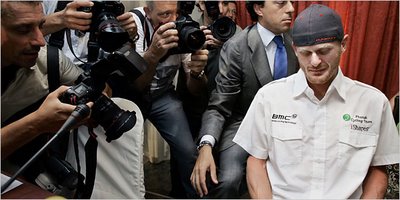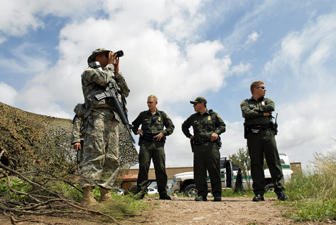 |
| National Guard and U.S. Border Patrol have their effective, yet separate tasks. Image Credit: The Washington Times |
The National Guard Deployment - S2 Mile Marker Mystery Tour - follow-on #3
With the vote of congress to fund 370 miles of fence and 500 miles of road barriers notwithstanding, the deployment of the National Guard becomes a "counter-chip" on the table to the "underground railroad" efforts that are in play around our southern border.
The calculation and mission of the deployment, however, is not really instructed to help dismantle the underground railroad efforts of groups aligned to help with the successful crossings of the people they are trying to detect.
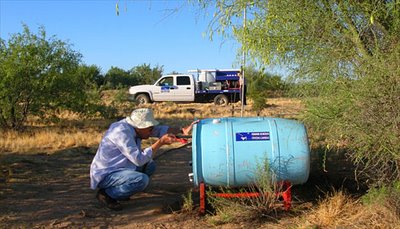 |
| Humane Borders, motivated by faith, offers humanitarian assistance to those in need through more than 70 emergency water stations on and near the U.S.-Mexican border. Image Credit: Humane Borders |
These group efforts include the Government of Mexico supported - Grupo Beta (described here at MAXINE, as Mexican-Spanish for 'plan-b', in that 'plan-a', a working economy and culture in Mexico, doesn't seem to be panning out), Border Angels (a U.S. based 'open-borders' socialist organization - see website), Humane Borders (a faith-based illegal alien 'humane' aid organization), and aid stations placed on land managed by and with the permission of the U.S. National Park Service; the Bureau of Land Management; the U.S. Fish and Wildlife Service.; and various State Government agencies of States along the southern border (including, I suspect, the aid stations along 15 miles of San Diego County Road S2).
This excerpted and edited from The Washington Times -
Standing guardBy Jerry Seper - THE WASHINGTON TIMES - August 13, 2006 - NOGALES, Ariz.
Sgt. Steven W. Jacobs of the Virginia National Guard, one of thousands of guardsmen from 30 states deployed along the southwest border with Mexico, says he arrived here with "no idea" of how vulnerable America is.
"I believe 95 percent of the people in this country have no clue of what it's like down here," says Sgt. Jacobs, a bear of a man with a vise-grip handshake. "I know I had no idea how many people come over this border every day and the weird things they do to get across.
"They'll do anything to get into the United States, often coming over with just the clothes on their back," he says. "And it's not just here; this happens all along the border. I was very surprised at what I saw when we first arrived, but I am here to protect my country, and I will stay as long as they need me."
Sgt. Jacobs, who lives in Fort A.P. Hill, Va., is among 350 Virginia National Guard soldiers and airmen deployed along the border as part of "Operation Jump Start." President Bush's $760 million plan calls for National Guard troops to be sent over the next two years to the U.S.-Mexico border from California to Texas. The goal: allowing the U.S. Border Patrol to move more agents into frontline positions.
Sgt. Jacobs and Spc. Jessica Jessee, also of Fort A.P. Hill, are assigned to an entry-identification team responsible for a popular corridor for illegal immigration along the border just west of here.
Members of the team work 24 hours on and 24 hours off to fight this invasion of illegal aliens while facing temperatures that rise above 100 degrees, fearsome thunderstorms that send rivers of water down nearby gullies and swarms of always-present flies.
Using binoculars, night-vision equipment and global positioning systems, the team seeks to spot anyone trying to enter the country illegally and to report their position to the Border Patrol. About a third of the National Guard force is assigned to entry-identification teams.
"It's a long, hard shift, but we have been very successful," Spc. Jessee says. "We do the best we can to keep tabs on what is going on in our area, and the Border Patrol has responded quickly to our calls."
----
On the hilltops just south of the border, Mexican spotters train equally sophisticated equipment on the Guard, directing smugglers of aliens and drugs to safer areas.
"They've got their own spotters watching us, trying to catch us when we're not looking," Sgt. Jacobs says.
----
'Significant dent'
Alien smugglers, he says, sometimes send people along the border to see how the Guard troops react and how quickly the Border Patrol responds. But he says his team has put a "significant dent" in the number of aliens crossing into his sector, with the daily count dropping from 150 to fewer than 20.
Watches all along the border have reported similar declines since the National Guard's arrival, says Border Patrol Chief David V. Aguilar, who notes that last week apprehensions were down by 45 percent since the start of Operation Jump Start.
----
Operation Jump Start was designed to free up Border Patrol agents for expanded enforcement duties along the 1,951-mile southwest border.
National Guard troops are building roads and fences, adding cameras and sensors, conducting aerial reconnaissance and providing medical aid and communications support. Guard troops also perform administrative duties, gather intelligence from border cameras for agents to act on, assist at highway checkpoints, serve on entry-identification teams and work as mechanics at Border Patrol stations, repairing well-worn trucks and cars.
The operation is expected to give the Border Patrol time to recruit and train 6,000 new agents to bring its field strength to 17,000.
----
"Probably the biggest thing we bring in terms of numbers and capability to the game are the additional eyes and ears of the initial-entry teams," Gen. Blum says. Border Patrol agents, he says, gain "greater situational awareness of what is going on in places where they could not go, or could not see, or could not hear what was happening before."
----
Trooping to border
In May, Mr. Bush sent Congress a request for $1.94 billion in emergency funding for border security. Besides money to pay for 6,000 new Border Patrol agents over the next two years, the president sought $770 million for the temporary deployment of 6,000 National Guard troops.
Thirty of the 54 states and territories with National Guard units have sent troops to the border, where they are quartered in motels and hotels. Maryland sent 120 National Guard troops to Arizona for 60 days earlier this month.
Customs and Border Protection Commissioner Ralph Basham, who oversees the Border Patrol, says the National Guard met the president's commitment of 6,000 troops by currently deploying 6,199 soldiers and airmen on the border. The troops are "forward deployed," he says, meaning they directly support the Border Patrol through surveillance, intelligence gathering, entry identification, engineering and other duties.
"The deployment of the National Guard has made a powerful impact on the security of our southern border," Mr. Basham says. "Fewer people are crossing our border, and this decline far exceeds any changes in border crossing due to seasonal migration patterns.
----
Although the troops are not involved directly in law enforcement, Mr. Basham says their presence led to the apprehension of 2,296 illegal aliens and the seizure of 64 vehicles, 14,496 pounds of marijuana and 220 pound of cocaine. The agency is "on track" to meet Mr. Bush's objective of doubling the number of Border Patrol agents by the end of 2008, he says.
The National Guard's priority target is Arizona, though troops are deployed along the border from California to Texas. The Arizona-Mexico border is the nation's most heavily traveled corridor for illegal immigration, accounting last year for about half of the 1.15 million illegal aliens detained nationwide. It also is a major drug-smuggling route into the United States.
'Eye-opening' service
All of the 6,199 Guard troops stationed in the border states volunteered for the mission. Among them is Spc. Travis Arnold of the Wisconsin National Guard, who also served a year in Iraq. He says he plans to help secure the border for two years.
"This certainly has been an eye-opening experience," Spc. Arnold says. "Immigration is not a huge issue in Wisconsin. It was the sheer number of people coming over that border that surprised me the most. I had no idea how many people jump that fence every day."
----
'Glad to be here'
Maj. Fay Ludens, a National Guard spokeswoman, says the troops "are glad to be here."
"Nobody is here who didn't want to be here," says Maj. Ludens, a member of the South Dakota National Guard who retires this month after 23 years. "I think we have all learned a lot about the Border Patrol and how the Border Patrol and the National Guard can work together.
"This call-out was a way for us to do something in the United States, helping our own."
Border Patrol spokesman Sean King says the Guard's presence in Nogales alone enabled that field office to free up 40 agents for enforcement duties along the border, a 10 percent staffing increase per shift. The increased manpower, he says, allows the office to put agents in areas "not now patrolled."
----
Gen. Blum, the Guard's bureau chief, describes Operation Jump Start as a law-enforcement operation rather than a military one. He says the Guard's role is to provide military support to civilian law enforcement, as directed by the president and the secretary of defense.
"We are not doing Border Patrol law-enforcement work," Gen. Blum says during a press conference in Washington. "We're doing everything else that other badge-carrying Border Patrol people used to have to do. We are replacing them so that they can get badges back to the border."
Read All>> (free subscription)
All efforts to secure our borders and have others respect our national sovereignty are appreciated, no doubt.
It would make a little more sense, however, to try and dismantle some of the infrastructure that has been put in place (supported by the efforts of Governmental and individual groups listed above) over the last decade to allow successful illegal immigration to take place.
At the very least, the efforts of our Government to support successful illegal immigration should stop if we are willing to put up fences and deploy our military in an effort to stop illegal immigration and secure our borders.






